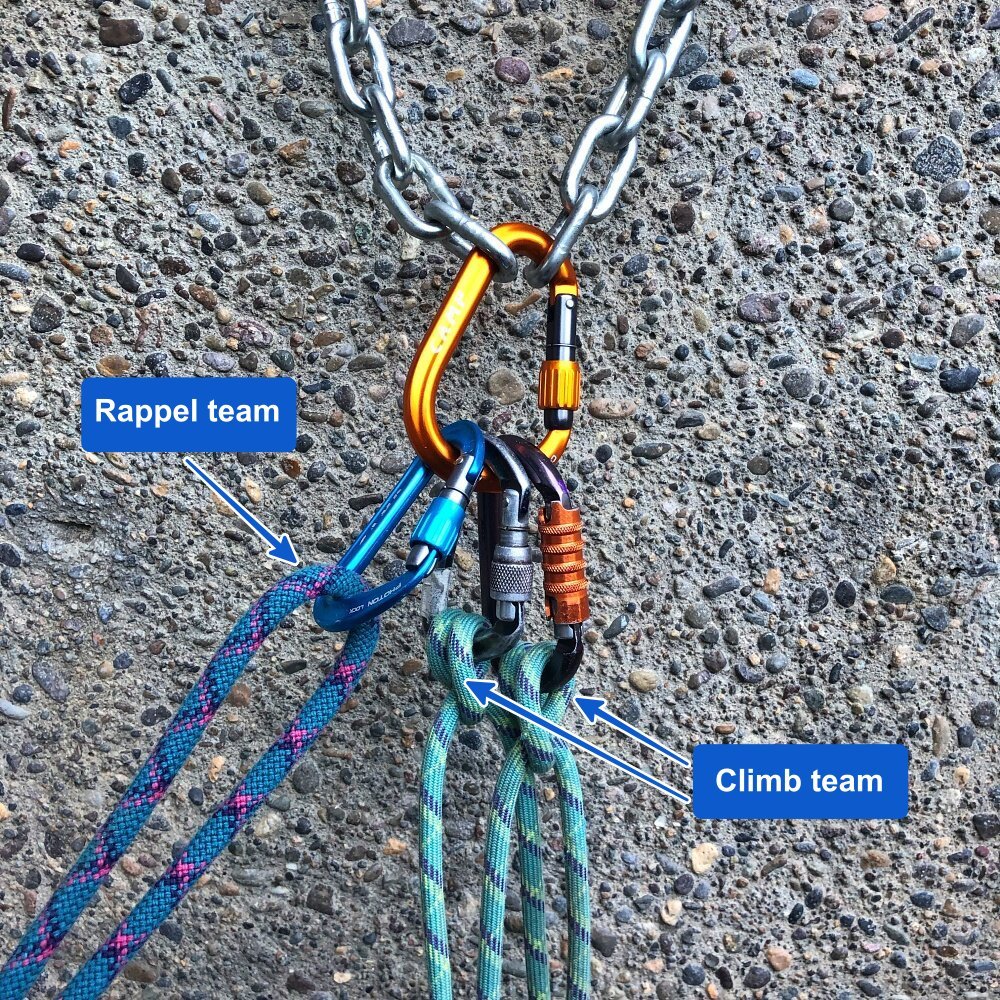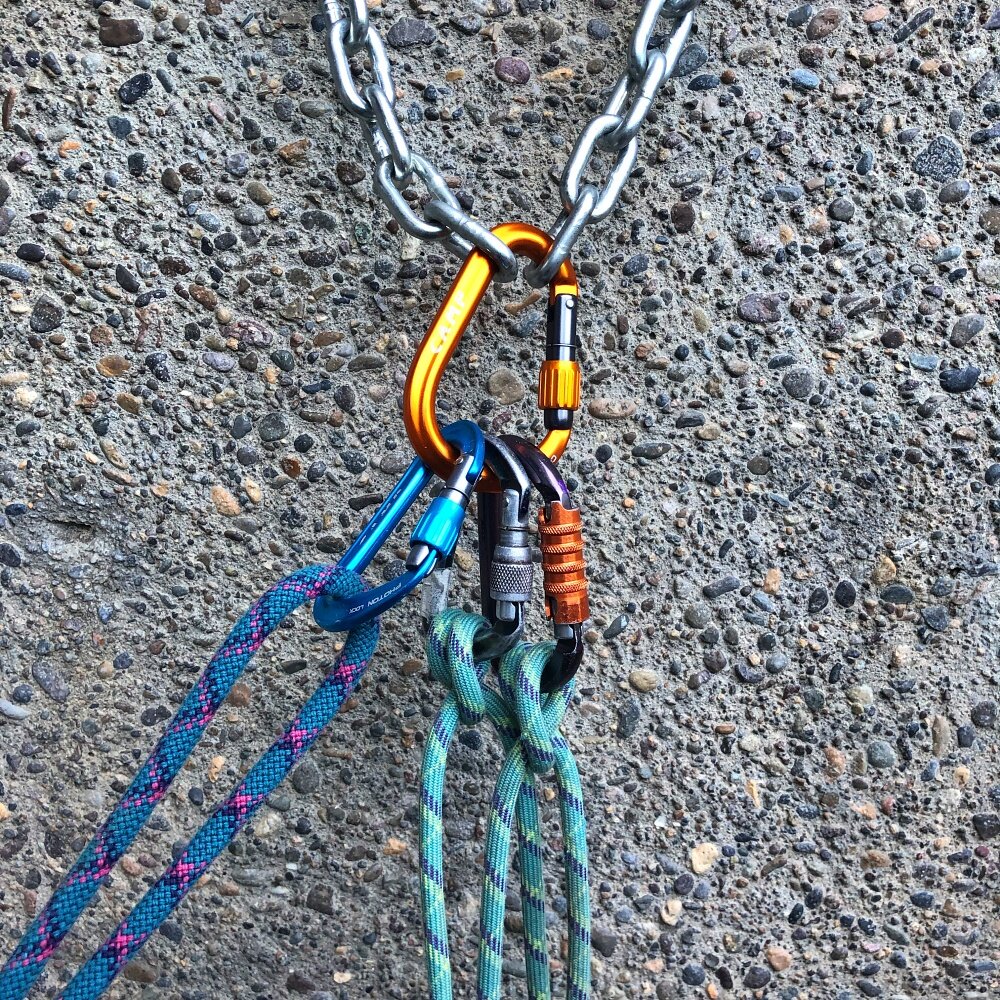Rappelling - How to pass other teams
Note - This post discusses techniques and methods used in vertical rope work. If you do them wrong, you could die. Always practice vertical rope techniques under the supervision of a qualified instructor, and ideally in a progression: from flat ground, to staircase, to vertical close to the ground before you ever try them in a real climbing situation.
Short version: the climbing team adds one of their locking carabiners onto their anchor. The rapelling team uses this carabiner to clip their rope, without threading the rope through the actual anchor hardware.
“You should never clip the rappel rings/chains for your anchor when ascending, because rappelling teams need to use them!”
Have you ever heard that one?
On a popular multi-pitch route with no walk off, where the descent rappel is the same as the climb, it's very common for a rappelling (descending) team needing to get past a climbing (ascending) team. (Red Rock Nevada, I’m looking at you.)
On a big wall climb, a team that's bailing / retreating may need to do many rappels, potentially onto other teams coming up the same route where the anchors might well be clogged with the typical big wall cluster.
The objective is simple: for the teams to pass as quickly, safely (and politely) as possible. So, what's a good way to do this?
While it’s probably drilled into your mind that when rappelling, you ALWAYS thread your rope through the existing hardware (chains, quicklink, ring) you actually don’t have to do this. All you really need is a safe place to attach your rappel rope.
To expedite passing, consider this (unconventional) method: the climbing team clips one of their locking carabiners to the master point of their anchor, and the rappelling team clips their rope to the climbing team’s carabiner.
To be clear, I am NOT saying that you should do this every time, or that you should build anchors that always obstruct the rappel hardware. Depending on the situation, it might be a better call for the descending team to use the chains, not your master point. This is another simply another tool in the toolbox for more advanced climbers.
What's cool about this method?
There's no finagling the rappel rope underneath any existing anchor cluster. Instead, it gets clipped on TOP of everything that’s already built. (This can be even more important on a big wall, where anchor chains might be clogged with gear and pretty much inaccessible.)
This can be a bit faster to set up, because you're simply clipping the middle mark to a carabiner, instead of threading the rope through the hardware and pulling half of it through.
To be fair, let's look at some possible downsides:
The climbing team can’t leave their anchor until the rappelling team is finished. Most of the time this shouldn’t be a problem, because a competent team rappelling should be down and through the anchor in just a few minutes. (If the climbing team is pretty much ready leave the anchor, then the rappelling team can simply wait for a couple minutes until the anchor is completely free.)
The climbing team may not have a spare locking carabiner. (Maybe the rappelling team can be generous and donate one of theirs.)
Having a legible and accurate middle mark on your rope is pretty much required. Fortunately most newer ropes have this. If yours does not, get a Beal rope marking pen and add one.
Hopefully obvious, but if the climbing team is on a sketchy anchor and the rappelling team is not comfortable using it, then you need to work out something else. (On popular routes, hopefully all the established anchors are well-maintained, so this should not be a problem.)
If the rappelling team has any rope issues, like tossing the rope, starting down, then having it get stuck or some other weirdness, the climbing team might be pretty much unable to move until it gets sorted out. Hopefully the team heading down is competent enough to get through smoothly and make a decent rope throw, but there's potential for a hang up here.
Maintaining good vibes:
While descending parties usually have the right-of-way, there’s no reason for anyone to be a jerk. You and your partner are out to have a good day climbing, same as the other team.
Whoever raps first, it might be wise to hang out (literally) for a minute next to the lower anchor, explain your approach, and get some buy-in from the other team before you just swing in and start rigging. Conversely, if you’re the ascending team and someone raps down to your anchor, explain to them that you have a way to make the pass happen faster, which benefits everyone. (Not many people are aware of this method, and you hopefully can use it as a teachable moment.)
Here's how to set it up.
The ascending team is using the bottom chain link as their master point. What inconsiderate jerks, how can anyone rappel past that!?
(Yeah, I know most people don't build anchors like this, but let’s use an extreme example - even when the chains are completely blocked, you can still rappel past it.)
No problem! The ascending team simply adds one of their locking carabiners (blue) to their master point carabiner . . .
. . . and the descending team clips their rope (blue) into the ascending team’s locker.
Are you concerned about multi-directional loading on the master carabiner? It's not really a problem.)




